Dongman Lee
Feature Augmentation based Test-Time Adaptation
Oct 18, 2024Abstract:Test-time adaptation (TTA) allows a model to be adapted to an unseen domain without accessing the source data. Due to the nature of practical environments, TTA has a limited amount of data for adaptation. Recent TTA methods further restrict this by filtering input data for reliability, making the effective data size even smaller and limiting adaptation potential. To address this issue, We propose Feature Augmentation based Test-time Adaptation (FATA), a simple method that fully utilizes the limited amount of input data through feature augmentation. FATA employs Normalization Perturbation to augment features and adapts the model using the FATA loss, which makes the outputs of the augmented and original features similar. FATA is model-agnostic and can be seamlessly integrated into existing models without altering the model architecture. We demonstrate the effectiveness of FATA on various models and scenarios on ImageNet-C and Office-Home, validating its superiority in diverse real-world conditions.
Spatio-Temporal Road Traffic Prediction using Real-time Regional Knowledge
Aug 23, 2024Abstract:For traffic prediction in transportation services such as car-sharing and ride-hailing, mid-term road traffic prediction (within a few hours) is considered essential. However, the existing road-level traffic prediction has mainly studied how significantly micro traffic events propagate to the adjacent roads in terms of short-term prediction. On the other hand, recent attempts have been made to incorporate regional knowledge such as POIs, road characteristics, and real-time social events to help traffic prediction. However, these studies lack in understandings of different modalities of road-level and region-level spatio-temporal correlations and how to combine such knowledge. This paper proposes a novel method that embeds real-time region-level knowledge using POIs, satellite images, and real-time LTE access traces via a regional spatio-temporal module that consists of dynamic convolution and temporal attention, and conducts bipartite spatial transform attention to convert into road-level knowledge. Then the model ingests this embedded knowledge into a road-level attention-based prediction model. Experimental results on real-world road traffic prediction show that our model outperforms the baselines.
Multiple Areal Feature Aware Transportation Demand Prediction
Aug 23, 2024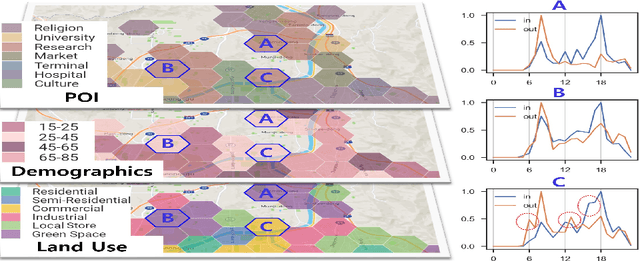
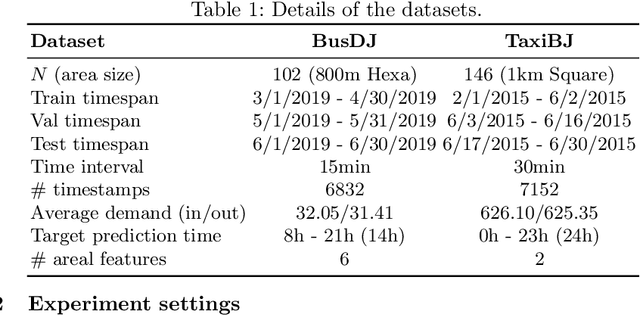
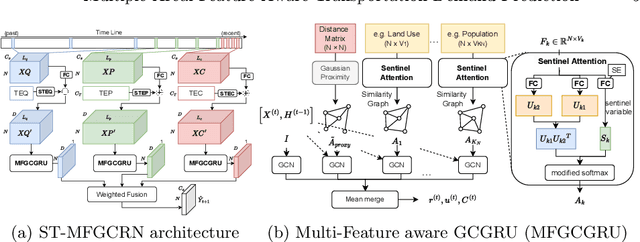
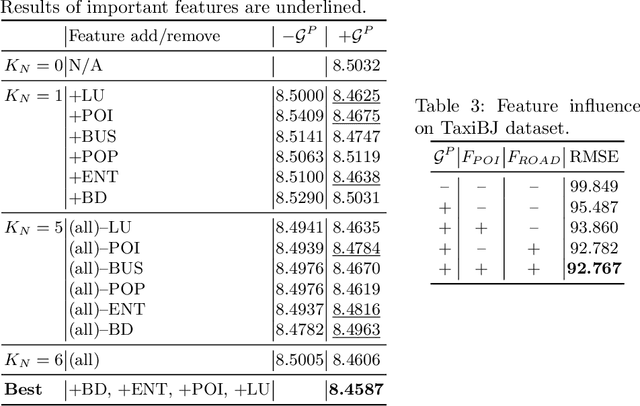
Abstract:A reliable short-term transportation demand prediction supports the authorities in improving the capability of systems by optimizing schedules, adjusting fleet sizes, and generating new transit networks. A handful of research efforts incorporate one or a few areal features while learning spatio-temporal correlation, to capture similar demand patterns between similar areas. However, urban characteristics are polymorphic, and they need to be understood by multiple areal features such as land use, sociodemographics, and place-of-interest (POI) distribution. In this paper, we propose a novel spatio-temporal multi-feature-aware graph convolutional recurrent network (ST-MFGCRN) that fuses multiple areal features during spatio-temproal understanding. Inside ST-MFGCRN, we devise sentinel attention to calculate the areal similarity matrix by allowing each area to take partial attention if the feature is not useful. We evaluate the proposed model on two real-world transportation datasets, one with our constructed BusDJ dataset and one with benchmark TaxiBJ. Results show that our model outperforms the state-of-the-art baselines up to 7\% on BusDJ and 8\% on TaxiBJ dataset.
CLAN: A Contrastive Learning based Novelty Detection Framework for Human Activity Recognition
Jan 17, 2024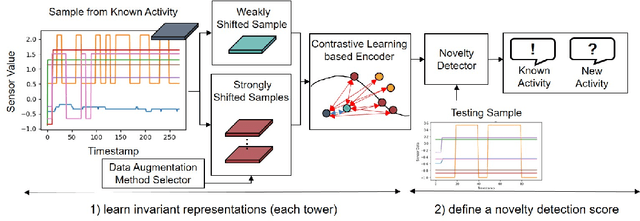


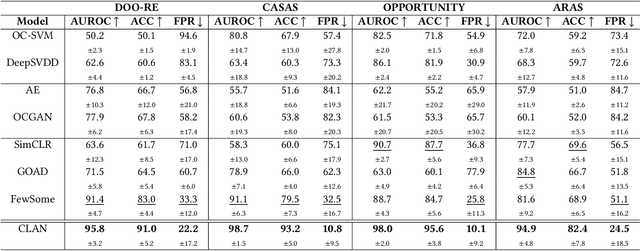
Abstract:In ambient assisted living, human activity recognition from time series sensor data mainly focuses on predefined activities, often overlooking new activity patterns. We propose CLAN, a two-tower contrastive learning-based novelty detection framework with diverse types of negative pairs for human activity recognition. It is tailored to challenges with human activity characteristics, including the significance of temporal and frequency features, complex activity dynamics, shared features across activities, and sensor modality variations. The framework aims to construct invariant representations of known activity robust to the challenges. To generate suitable negative pairs, it selects data augmentation methods according to the temporal and frequency characteristics of each dataset. It derives the key representations against meaningless dynamics by contrastive and classification losses-based representation learning and score function-based novelty detection that accommodate dynamic numbers of the different types of augmented samples. The proposed two-tower model extracts the representations in terms of time and frequency, mutually enhancing expressiveness for distinguishing between new and known activities, even when they share common features. Experiments on four real-world human activity datasets show that CLAN surpasses the best performance of existing novelty detection methods, improving by 8.3%, 13.7%, and 53.3% in AUROC, balanced accuracy, and FPR@TPR0.95 metrics respectively.
DOO-RE: A dataset of ambient sensors in a meeting room for activity recognition
Jan 17, 2024Abstract:With the advancement of IoT technology, recognizing user activities with machine learning methods is a promising way to provide various smart services to users. High-quality data with privacy protection is essential for deploying such services in the real world. Data streams from surrounding ambient sensors are well suited to the requirement. Existing ambient sensor datasets only support constrained private spaces and those for public spaces have yet to be explored despite growing interest in research on them. To meet this need, we build a dataset collected from a meeting room equipped with ambient sensors. The dataset, DOO-RE, includes data streams from various ambient sensor types such as Sound and Projector. Each sensor data stream is segmented into activity units and multiple annotators provide activity labels through a cross-validation annotation process to improve annotation quality. We finally obtain 9 types of activities. To our best knowledge, DOO-RE is the first dataset to support the recognition of both single and group activities in a real meeting room with reliable annotations.
A Causality-Aware Pattern Mining Scheme for Group Activity Recognition in a Pervasive Sensor Space
Dec 01, 2023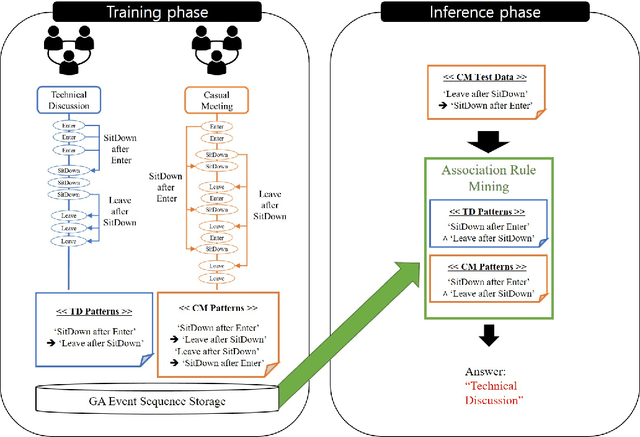
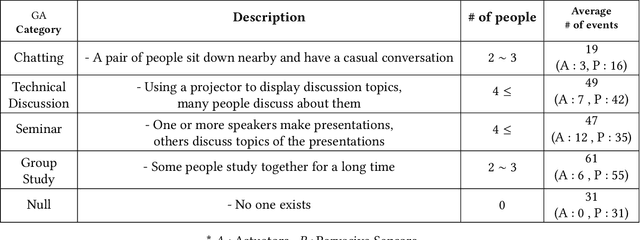


Abstract:Human activity recognition (HAR) is a key challenge in pervasive computing and its solutions have been presented based on various disciplines. Specifically, for HAR in a smart space without privacy and accessibility issues, data streams generated by deployed pervasive sensors are leveraged. In this paper, we focus on a group activity by which a group of users perform a collaborative task without user identification and propose an efficient group activity recognition scheme which extracts causality patterns from pervasive sensor event sequences generated by a group of users to support as good recognition accuracy as the state-of-the-art graphical model. To filter out irrelevant noise events from a given data stream, a set of rules is leveraged to highlight causally related events. Then, a pattern-tree algorithm extracts frequent causal patterns by means of a growing tree structure. Based on the extracted patterns, a weighted sum-based pattern matching algorithm computes the likelihoods of stored group activities to the given test event sequence by means of matched event pattern counts for group activity recognition. We evaluate the proposed scheme using the data collected from our testbed and CASAS datasets where users perform their tasks on a daily basis and validate its effectiveness in a real environment. Experiment results show that the proposed scheme performs higher recognition accuracy and with a small amount of runtime overhead than the existing schemes.
Beyond Entropy: Style Transfer Guided Single Image Continual Test-Time Adaptation
Nov 30, 2023



Abstract:Continual test-time adaptation (cTTA) methods are designed to facilitate the continual adaptation of models to dynamically changing real-world environments where computational resources are limited. Due to this inherent limitation, existing approaches fail to simultaneously achieve accuracy and efficiency. In detail, when using a single image, the instability caused by batch normalization layers and entropy loss significantly destabilizes many existing methods in real-world cTTA scenarios. To overcome these challenges, we present BESTTA, a novel single image continual test-time adaptation method guided by style transfer, which enables stable and efficient adaptation to the target environment by transferring the style of the input image to the source style. To implement the proposed method, we devise BeIN, a simple yet powerful normalization method, along with the style-guided losses. We demonstrate that BESTTA effectively adapts to the continually changing target environment, leveraging only a single image on both semantic segmentation and image classification tasks. Remarkably, despite training only two parameters in a BeIN layer consuming the least memory, BESTTA outperforms existing state-of-the-art methods in terms of performance.
Improving Real Estate Appraisal with POI Integration and Areal Embedding
Nov 20, 2023


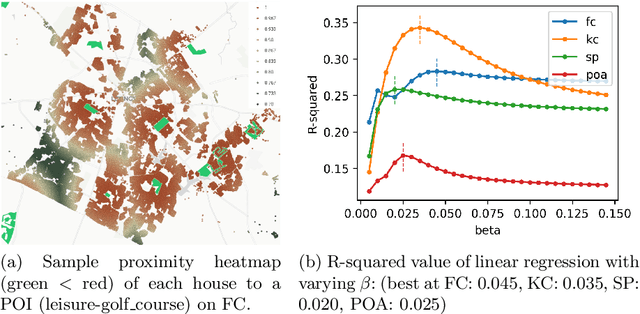
Abstract:Despite advancements in real estate appraisal methods, this study primarily focuses on two pivotal challenges. Firstly, we explore the often-underestimated impact of Points of Interest (POI) on property values, emphasizing the necessity for a comprehensive, data-driven approach to feature selection. Secondly, we integrate road-network-based Areal Embedding to enhance spatial understanding for real estate appraisal. We first propose a revised method for POI feature extraction, and discuss the impact of each POI for house price appraisal. Then we present the Areal embedding-enabled Masked Multihead Attention-based Spatial Interpolation for House Price Prediction (AMMASI) model, an improvement upon the existing ASI model, which leverages masked multi-head attention on geographic neighbor houses and similar-featured houses. Our model outperforms current baselines and also offers promising avenues for future optimization in real estate appraisal methodologies.
MetaWeather: Few-Shot Weather-Degraded Image Restoration via Degradation Pattern Matching
Sep 05, 2023Abstract:Real-world vision tasks frequently suffer from the appearance of adverse weather conditions including rain, fog, snow, and raindrops in captured images. Recently, several generic methods for restoring weather-degraded images have been proposed, aiming to remove multiple types of adverse weather effects present in the images. However, these methods have considered weather as discrete and mutually exclusive variables, leading to failure in generalizing to unforeseen weather conditions beyond the scope of the training data, such as the co-occurrence of rain, fog, and raindrops. To this end, weather-degraded image restoration models should have flexible adaptability to the current unknown weather condition to ensure reliable and optimal performance. The adaptation method should also be able to cope with data scarcity for real-world adaptation. This paper proposes MetaWeather, a few-shot weather-degraded image restoration method for arbitrary weather conditions. For this, we devise the core piece of MetaWeather, coined Degradation Pattern Matching Module (DPMM), which leverages representations from a few-shot support set by matching features between input and sample images under new weather conditions. In addition, we build meta-knowledge with episodic meta-learning on top of our MetaWeather architecture to provide flexible adaptability. In the meta-testing phase, we adopt a parameter-efficient fine-tuning method to preserve the prebuilt knowledge and avoid the overfitting problem. Experiments on the BID Task II.A dataset show our method achieves the best performance on PSNR and SSIM compared to state-of-the-art image restoration methods. Code is available at (TBA).
Enhancing Spatiotemporal Traffic Prediction through Urban Human Activity Analysis
Aug 20, 2023
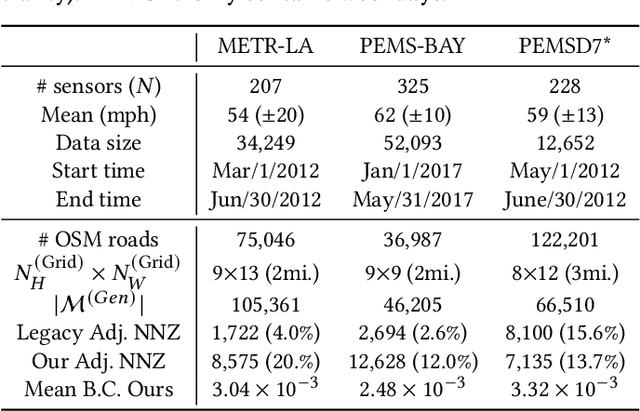

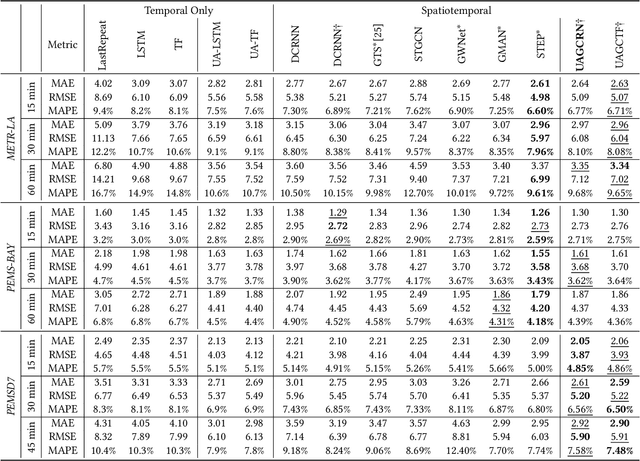
Abstract:Traffic prediction is one of the key elements to ensure the safety and convenience of citizens. Existing traffic prediction models primarily focus on deep learning architectures to capture spatial and temporal correlation. They often overlook the underlying nature of traffic. Specifically, the sensor networks in most traffic datasets do not accurately represent the actual road network exploited by vehicles, failing to provide insights into the traffic patterns in urban activities. To overcome these limitations, we propose an improved traffic prediction method based on graph convolution deep learning algorithms. We leverage human activity frequency data from National Household Travel Survey to enhance the inference capability of a causal relationship between activity and traffic patterns. Despite making minimal modifications to the conventional graph convolutional recurrent networks and graph convolutional transformer architectures, our approach achieves state-of-the-art performance without introducing excessive computational overhead.
 Add to Chrome
Add to Chrome Add to Firefox
Add to Firefox Add to Edge
Add to Edge